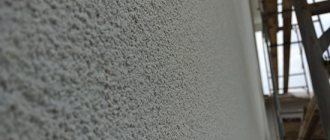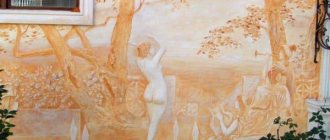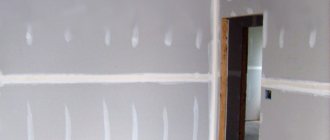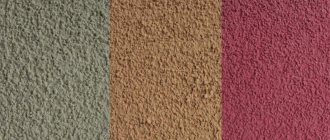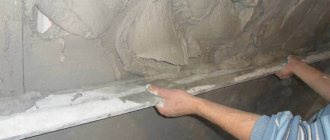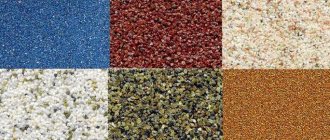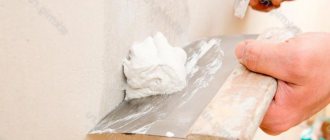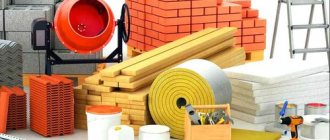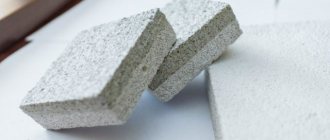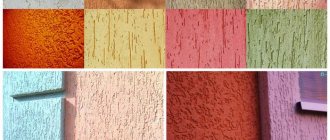FILTER
In comparison (0)
Art. 0831
Moscow and region: Vidnoye, Belokamenny highway, ow. 10 170 Availability as of 01/14/2022 2nd Irtyshsky Ave., 2A, building 3 145 Availability as of 01/14/2022 Istra district, village of Zakharovo, ow. 57 7 Availability as of 01/14/2022 Central warehouse 2450 Availability as of 01/14/2022
Cement plaster Leveling MN, 40 kg
431
In stock
For leveling walls made of concrete, brick and cellular concrete. Finishing of facades and rooms with any level of humidity provides reliable protection of facades from atmospheric influences. Vapor permeable. Manual and mechanical application. For interior and exterior use.
BUY
Art. 6314
Moscow and region: Istrinsky district, village Zakharovo, vl. 57 42 Availability as of 01/14/2022 Central warehouse 321 Availability as of 01/14/2022
Technology of using plaster
The main stage of work includes preparing the necessary construction tools. Materials will be needed in the process of preparing and applying sand mortar to the surface. Basic tools are needed to prepare the cement mixture, additional tools are needed to facilitate the process of spreading the plaster over the wall.
| Basic | Auxiliary |
| plastering ladle | cord made of fishing line, nylon |
| aluminum, wooden slats | spray |
| Putty knife | hammer |
| vertical, horizontal level | chisel |
| painting beacons | saw |
| Shovel | paint brush |
| container for solution |
Cement plaster Leveling MN Winter series, 40 kg
480
In stock
For leveling walls made of concrete, brick and cellular concrete. Finishing of facades and rooms with any level of humidity provides reliable protection of facades from atmospheric influences. Vapor permeable. Manual and mechanical application. For interior and exterior use. In an extended temperature range up to -10 °C.
BUY
Art. 2965
Moscow and region: Vidnoye, Belokamenny highway, ow. 10 95 Availability as of 01/14/2022 2nd Irtyshsky pr., 2A, building 3 5 Availability as of 01/14/2022 Central warehouse 2391 Availability as of 01/14/2022
Thin-layer cement plaster MN, 40 kg
440
In stock
For leveling with a layer from 3 to 30 mm. walls made of concrete, brick and cellular concrete. Finishing of facades, plinths and rooms with any level of humidity. Provides reliable protection of facades from atmospheric influences. For manual and machine application. Reinforced with fiber fibre. For external and internal works. Color grey. Weight 40 kg.
BUY
Art. 6086
Moscow and region: Central warehouse 540 Availability as of 01/14/2022
Application process
To ensure the quality of the plaster layer, a certain sequence is required. Let's look at them below.
Preparing the base
Before laying the plaster, the surface must be prepared, that is, old paint, wallpaper, etc. must be removed from the surface to be treated. In addition, all surface defects must be repaired - cracks, potholes, and crumbling areas must also be treated. Ideally, the surface should be smooth and clean before installation.
Damaged areas are identified by simple visual inspection. To detect hidden defective places, you can knock on the wall with a hammer and if during tapping a dull knock is heard, this indicates the presence of damage.
In these places it is necessary to remove a layer of material; if the holes are deep, then you can lay a reinforcing mesh in them, or simply fill them with nails.
Before laying the plaster, the surface must be prepared, that is, old paint, wallpaper, etc. must be removed from the surface to be treated.
Installation of beacons
Beacon - this guide piece is necessary to guide the rule when leveling the plaster layer. Their use allows you to save up to 30% of the solution, in addition, the work is significantly accelerated. Various methods are used to secure them. The lighthouse itself can be either a galvanized metal profile, or specially made parts, they are called “ears”.
When installing beacons, you will need to use a grueling construction tool, preferably a laser.
Beacon - this guide piece is necessary to guide the rule when leveling the plaster layer.
Preparation of cement mortar
Of course, it is impossible to carry out the work without a ready-made solution; to prepare it you will need the tools listed above. The composition of the solution depends on the operating conditions. For example, a composition with proportions 1:1:6 and 1:2:9. We are talking about cement, lime milk and sand.
The composition of the solution depends on the operating conditions.
Plastering depending on the wall material
The solution is applied in several layers; this can be done manually or using mechanized means. The first layer is called spray, its thickness should be 5 mm. After it dries, a primer layer is applied; it is denser and makes up the base thickness of the entire coating. To ensure a smooth surface, a third layer, called an overlay, is applied. The thickness of this layer is no more than 2 mm.
The solution is applied in several layers; this can be done manually or using mechanized means.
Plaster mortar applied to a wall or other surface creates a reliable barrier to moisture. In addition, it is not susceptible to the effects of biological damage. The low level of thermal conductivity allows you to save costs and thermal energy.
Cement plaster Thin-layer Winter series, 40 kg
530
In stock
For leveling with a layer from 3 to 30 mm. walls made of concrete, brick and cellular concrete. Finishing of facades, plinths and rooms with any level of humidity. Provides reliable protection of facades from atmospheric influences. For manual and machine application. Reinforced with fiber fibre. For external and internal works. In an extended temperature range up to -10°C. Color grey. Weight 40 kg.
BUY
Art. 0541
Moscow and region: MKAD, Kaluzhskoe sh., 4, building 5 12 Availability as of 01/14/2022 Central warehouse 642 Availability as of 01/14/2022
Marking of plaster mixture
Let's start with the fact that previously this composition was prepared directly on a construction site or inside a building that was undergoing renovation. Because the composition of the material is simple. It includes cement and sand, which were mixed and diluted with water. The main task is to strictly adhere to the recipe, that is, the exact ratio of ingredients in order to provide the required brand of solution.
Today, manufacturers of dry mixes offer ready-made solutions into which the components are added strictly according to the recipe. Of course, except for water. The finished leveling material is obtained by mixing the dry mixture with a certain amount of water, which is indicated on the packaging.
As for labeling, manufacturers offer a complete set. Namely:
- M50 - used for repair work, for example, sealing cracks and seams;
- M100 is a cement-sand plaster for interior work;
- M150 – for external use;
- M200 and M300 - for special structures where increased strength is required.
Let’s make a reservation that M150 can be used both as a repair mixture and for interior spaces. But it’s better not to use M50 for leveling.
Variety of cement plasters Source rem177.ru
As for making it on site, as plasterers did in the past, there are no restrictions. You just need to know the recipe and strictly follow the proportions of the mixed materials.
- To obtain the M50 , you need to mix cement and sand in a ratio of 1:6.
- M100 – ratio 1:5.
- M150 – ratio 1:3.
It should be taken into account that cement grade M300 is used for this. If you add a higher grade of cement, for example M400, to the mixture, the ratio of ingredients will change. So, to obtain a cement-sand mortar of grade M150, it is necessary to mix the components in a ratio of 1:4.
Manufacturers of ready-mixes add plasticizers and modifiers to the composition, which improve the technical and operational characteristics of the material. For example, they increase plasticity and viscosity. By adding particles of insulation, the thermal insulation properties are increased.
How to prepare cement-sand mortar Source fasad-exp.ru
Light cement plaster Frontpro Light MN, 30 kg
427
In stock
For high-quality leveling of walls and ceilings in a layer of 5 to 50 mm. inside and outside buildings, creating after drying a durable, vapor-permeable, crack-resistant layer that reduces heat loss. It has low consumption, is easy to apply and level, and provides reliable protection of facades from atmospheric influences. Recommended for application using all types of plastering stations and for manual application. Color grey. Weight 30 kg.
BUY
Art. 1586
Moscow and region: MKAD, Kaluzhskoe sh., 4, building 5 28 Availability as of 01/14/2022
Preparatory stage of work
Before plastering walls using sand-cement mortar, it is necessary to prepare the surface for finishing. The preliminary stage of processing depends on the characteristics of the walls.
| Surface material | Method of preparation |
| Tree |
|
| Brick |
|
| Concrete |
|
The preliminary stage of preparing the external surfaces of buildings involves the use of sheathing, stripping and subsequent application of a primer layer. Treatment of external surfaces made of brick, concrete or wood must be carried out at positive temperatures.
The preparatory stage of work, regardless of the surface material, involves removing construction imperfections (gaps, bulges, protrusions), cleaning from dirt, dust, and stains. Applying a protective layer using glue and a primer mixture provides waterproofing. If desired, you can use an antibacterial solution to prevent the occurrence of fungus and mold.
Before plastering the walls with sand-cement mortar, it is necessary to install construction beacons on the surfaces, which are metal fasteners that are fixed vertically along the height of the wall. Additional elements are auxiliary means for accurately determining the level of the finishing layer. To install the beacon, it is necessary to use gypsum, which is applied pointwise along the height of the surface at a distance of half a meter from each other. To secure the elements proportionally, it is necessary to use diagonal levels. The horizontal distance between paint beacons should not exceed one and a half meters.
Light cement plaster Frontpro Light Winter series, 30 kg
505
In stock
For high-quality leveling of walls and ceilings in a layer of 5 to 50 mm. inside and outside buildings, creating after drying a durable, vapor-permeable, crack-resistant layer that reduces heat loss. It has low consumption, is easy to apply and level, and provides reliable protection of facades from atmospheric influences. Recommended for application using all types of plastering stations and for manual application. In an extended temperature range up to -10°C. Color grey. Weight 30 kg.
BUY
Art. 2729
Moscow and region: st. Generala Dorokhova, 10B, building 2 400 Availability as of 01/14/2022 2nd Irtyshsky Ave., 2A, building 3 102 Availability as of 01/14/2022 Vidnoye, Belokamenny Highway, ow. 10 92 Availability as of 01/14/2022 Istrinsky district, village of Zakharovo, ow. 57 1 Availability as of 01/14/2022 Central warehouse 2892 Availability as of 01/14/2022
Universal cement plaster Frontpro Standard, 25 kg
282
In stock
For leveling walls with a layer of 5 to 40 mm. from concrete, brick, stone, aerated concrete and foam concrete, as well as for leveling cement-lime and cement-sand bases. It is used inside and outside buildings (facades, basements and rooms with any degree of humidity). It has high crack resistance and provides reliable protection of facades from atmospheric influences. Fiber reinforced. Apply manually or mechanically. Color grey. Weight 25 kg.
BUY
Art. 5102
Moscow and region: Central warehouse 832 Availability as of 01/14/2022
Tools and materials needed for work
To obtain the composition yourself, you will need the availability and use of the following materials and tools:
- An electric drill with a mixer attachment or a professional mixer.
- Water, preferably filtered.
- Screened cement and sand cement.
- Lime dough or milk.
To independently obtain the composition, you will need the availability and use of certain materials and tools.
Universal thin-layer cement plaster Frontpro Standard Plus, 25 kg
315
In stock
For leveling walls with a layer of 3 to 30 mm. facades, basements and rooms with any degree of humidity. It is used for subsequent finishing: finishing thin-layer putty, finishing with decorative plasters, tiled cladding. Forms a smooth surface that is suitable for painting without additional putty. It has high crack resistance and provides reliable protection of facades from atmospheric influences. For interior and exterior use. Apply manually or mechanically. Color grey. Weight 25 kg.
BUY
Art. 4013
Moscow and region: Central warehouse 3 Availability as of 01/14/2022
Best manufacturers and price
The final result also depends on the manufacturer. Little-known companies may produce low-quality raw materials that crack and peel. Therefore, it is better not to save money and choose a good brand.
List of verified companies:
- Cement plaster Knauf (Germany). The company has established itself as one of the best among the creators of building mixtures. The reviews are only positive. Knauf Grünband cement plaster 25 kg is especially praised. Price – 240 rub. per bag.
- Prospectors cement plaster (Russia). Each option complies with GOST standards. The company has been in business since 1992. Prices – 200-220 rubles. per bag 25 kg.
- Cement plaster Ceresit (Germany). Excellent value for money and quality. From 400 to 500 rubles.
Worth mentioning are the Polish company Atlas, the Russian Bolars, Osnovit, Volma, the German Caparol and the Austrian Baumit.
Cement mixture is a universal option for finishing a room. It is affordable, practical, durable, moisture-resistant and effective. Knowing all the intricacies of working with the material, as well as variations, you can complete the finishing efficiently and quickly.
Universal cement plaster Frontpro Standard Winter series, 25 kg
366
In stock
For leveling walls with a layer of 5 to 40 mm. from concrete, brick, stone, aerated concrete and foam concrete, as well as for leveling cement-lime and cement-sand bases. It is used inside and outside buildings (facades, basements and rooms with any degree of humidity). It has high crack resistance and provides reliable protection of facades from atmospheric influences. Fiber reinforced. Apply manually or mechanically. In an extended temperature range up to -10°C. Color grey. Weight 25 kg.
BUY
Art. 2736
Moscow and region: 2nd Irtyshsky pr., 2A, building 3 151 Availability as of 01/14/2022 Central warehouse 1362 Availability as of 01/14/2022
Plastering rules
Plastering walls with cement-sand mortar is not an easy process. Experience is required to obtain a high quality end result. Therefore, novice builders spend a long time as apprentices to become plasterers.
Let's start with the fact that plastering brick walls, or those built from other materials, begins with determining the evenness of the treated surface. That is, it is necessary to determine the curvature of the walls, and, accordingly, the thickness of the plaster layer. It is clear that the thicker the latter, the more material will have to be spent on it. Usually the plane difference is determined by a plumb line; today a laser level is used for this.
Determining the curvature of a wall with a laser level Source klademkirpich.ru
See also: Catalog of companies that specialize in finishing work and insulation of houses.
Now pay attention to the thickness of the layer. If this parameter exceeds 5 cm, then a plaster mesh will need to be installed on the wall. And the plastering process itself will have to be carried out in several layers. At the same time, in order to apply the next layer, the previous one must dry well. And this can take a lot of time. That is why, increasingly, large differences in wall planes are leveled with sheet or panel building materials. For example, drywall.
Plaster consists of several layers Source odzakladov.sk
If the difference in plane is small, then plastering is still carried out in three layers:
- Spray . This is a semi-liquid cement-sand mortar, the purpose of which is to fill the seams, gaps and cracks between the wall material. Before applying it, the brick wall must be wetted. Because a dry wall will begin to draw water out of the solution, which will reduce the characteristics of the latter. Typically the spray recipe is: 1:2.5 – 1:4. Apply it in a layer of no more than 1 cm.
- The second layer is called soil . This is the main leveling layer that is applied along the beacons. It is the thickest and heaviest, so the solution for it must be very plastic. According to the recipe, it is made based on the ratio of cement and sand - 1: 2-3.
- Covering . In fact, this is, so to speak, the finishing plaster layer, also known as grout. He is the thinnest. And its task is to cover all soil defects. It is made in the form of a liquid mixture in a ratio of cement and sand - 1:2. The proportions were chosen as such because the last layer should be the strongest.
Applying a coating to the ground Source yandex.net
Lightweight cement-lime plaster Frontpro Master, 30 kg
374
In stock
For leveling walls inside and outside buildings (facades, basements and rooms with any degree of humidity). Apply in a layer of 5 to 40 mm. It is used for subsequent finishing: finishing thin-layer putty, finishing with decorative plasters, tiling or painting. For interior and exterior use. Apply manually or mechanically. Color grey. Weight 30 kg.
BUY
Art. 5065
Moscow and region: MKAD, Kaluzhskoe sh., 4, building 5 5 Availability as of 01/14/2022 Central warehouse 1 Availability as of 01/14/2022
Lightweight smooth cement-lime plaster Frontpro Master Plus, 25 kg
360
In stock
For leveling walls with a layer of 5 to 50 mm (facades, basements and rooms with any degree of humidity). It is used for subsequent finishing: finishing thin-layer putty, finishing with decorative plasters, tiled cladding. Forms a smooth surface that is suitable for painting without additional putty. Provides reliable protection of facades from atmospheric influences and has water-repellent properties. After drying, it creates a durable, vapor-permeable and crack-resistant layer. For interior and exterior use. Apply manually or mechanically. Color grey. Weight 25 kg.
BUY
Art. 4006
Moscow and region: Central warehouse 19 Availability as of 01/14/2022
How to properly mix plaster mortar
It all depends on the volume in which the work with plaster will be done. On large projects a construction mixer is used. For small spaces, a screwdriver with an appropriate attachment and a construction plastic bucket will be sufficient.
The bucket is cleared of dust and debris, a little cement-sand mixture is poured into it, making sure that the mixture looks homogeneous in a loose state. If this is not the case, then mix it with a trowel even before adding water.
Cold, clean water is gradually added to the dry mixture so that it can be conveniently stirred with a tool. It is important not to overload the screwdriver with a mixture that is too thick in consistency, which will simply “screw” onto the attachment. Also, when mixing, you should be guided by two principles: the mixture should not be too liquid, so as not to drain under its own weight; and the mixture should not be too thick so that it is difficult to level.
Advice! Do not knead a large amount of the mixture at once. Its plasticity will change for the worse already 20 minutes after preparing the solution.
Before you start creating a new portion of the solution, you should thoroughly clean the plastic bucket from clots of the used mixture.
Lightweight cement-lime plaster Frontpro Master Winter series, 30 kg
432
In stock
For leveling walls inside and outside buildings (facades, basements and rooms with any degree of humidity). Apply in a layer of 5 to 40 mm. It is used for subsequent finishing: finishing thin-layer putty, finishing with decorative plasters, tiling or painting. For interior and exterior use. In an extended temperature range up to -10°C. Apply manually or mechanically. Color grey. Weight 30 kg.
BUY
Art. 5072
Moscow and region: Central warehouse 11 Availability as of 01/14/2022
High-strength cement plaster Frontpro Expert, 25 kg
364
In stock
For leveling walls with a layer of 5 to 40 mm. facades, plinths, terraces, basements and rooms with any degree of humidity. Provides reliable protection of facades and plinths from atmospheric influences and has water-repellent properties. Forms a durable and crack-resistant surface with high load-bearing capacity, sufficient for subsequent cladding with all types of natural and artificial stone, as well as large-format porcelain tiles. Compressive strength 12 MPa. Fiber reinforced. For interior and exterior use. Apply manually or mechanically. Color grey. Weight 25 kg.
BUY
Art. 5089
Moscow and region: Central warehouse 3 Availability as of 01/14/2022
Specifications
The thermal conductivity and strength of a material depend on density. In their pure form, without any additives, the solutions are heavy; in the solidified state, their density is 1600-1800 kg/m3. The result is a durable coating, suitable even for floor screed. Due to high density, high thermal conductivity. Gypsum is porous, and plaster has a thermal conductivity coefficient of 0.9 W (m*K).
The walls in the room must absorb excess moisture, removing it outside so that condensation does not form. Therefore, when choosing a material, vapor permeability is taken into account. For cement mortar this figure is 0.09 mg/mhPa.
At temperatures up to +25 degrees, a layer two centimeters thick takes on average fourteen hours to dry. With a larger layer, of course, the drying time also increases. To be sure, it is recommended not to touch the plastered walls for a whole day.
You also need to pay attention to the consumption of plaster. Dry TsPSh are cheaper than gypsum, but their consumption per square meter is higher
Usually the packaging indicates how much material will be needed to create a layer for one square meter.
High-strength thin-layer cement plaster Frontpro Expert Plus, 25 kg
372
In stock
For leveling facades, basements and rooms with any degree of humidity. It is used for subsequent finishing: finishing thin-layer putty, finishing with decorative plasters, tiled cladding. Forms a smooth surface that is suitable for painting without additional putty. Provides reliable protection of facades from atmospheric influences and has water-repellent properties. After drying, it creates a durable, vapor-permeable and crack-resistant layer. Fiber reinforced. Compressive strength 12 MPa. Color grey. Weight 25 kg.
BUY
Art. 6079
Moscow and region: Central warehouse 49 Availability as of 01/14/2022
High-strength cement plaster Frontpro Expert Winter series, 25 kg
415
In stock
For leveling walls with a layer of 5 to 40 mm. facades, plinths, terraces, basements and rooms with any degree of humidity. Provides reliable protection of facades and plinths from atmospheric influences and has water-repellent properties. Forms a durable and crack-resistant surface with high load-bearing capacity, sufficient for subsequent cladding with all types of natural and artificial stone, as well as large-format porcelain tiles. Compressive strength 12 MPa. Fiber reinforced. For interior and exterior use. In an extended temperature range up to -10°C. Apply manually or mechanically. Color grey. Weight 25 kg.
BUY
Art. 5096
Moscow and region: Central warehouse 27 Availability as of 01/14/2022
